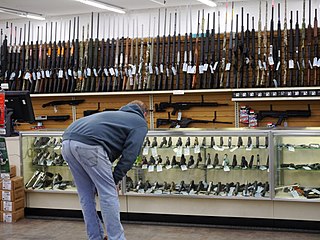Related Research Articles

Gun control, or firearms regulation, is the set of laws or policies that regulate the manufacture, sale, transfer, possession, modification, or use of firearms by civilians.

More Guns, Less Crime is a book by John R. Lott Jr. that says violent crime rates go down when states pass "shall issue" concealed carry laws. He presents the results of his statistical analysis of crime data for every county in the United States during 29 years from 1977 to 2005. Each edition of the book was refereed by the University of Chicago Press. The book examines city, county and state level data from the entire United States and measures the impact of 13 different types of gun control laws on crime rates. The book expands on an earlier study published in 1997 by Lott and his co-author David Mustard in The Journal of Legal Studies and by Lott and his co-author John Whitley in The Journal of Law and Economics, October 2001.
Gun laws in Australia are predominantly within the jurisdiction of Australian states and territories, with the importation of guns regulated by the federal government. In the last two decades of the 20th century, following several high-profile killing sprees, the federal government coordinated more restrictive firearms legislation with all state governments. Gun laws were largely aligned in 1996 by the National Firearms Agreement. In two federally funded gun buybacks and voluntary surrenders and State Governments' gun amnesties before and after the Port Arthur Massacre, more than a million firearms were collected and destroyed, possibly a third of the national stock.
Concealed carry, or carrying a concealed weapon (CCW), is the practice of carrying a weapon in public in a concealed manner, either on one's person or in close proximity. CCW is often practiced as a means of self-defense. Every state in the United States allows for concealed carry of a handgun either permitless or with a permit, although the difficulty in obtaining a permit varies per jurisdiction.

A suicide method is any means by which a person chooses to end their life. Suicide attempts do not always result in death, and a nonfatal suicide attempt can leave the person with serious physical injuries, long-term health problems, and brain damage.

An estimated 1 million people worldwide die by suicide every year. Globally, suicide ranks among the three leading causes of death among those aged 15–44 years. Attempted suicides are up to 20 times more frequent than completed ones.
A waiting period is the period of time between when an action is requested or mandated and when it occurs.

Gun violence in the United States results in tens of thousands of deaths and injuries annually, and was the leading cause of death for children 19 and younger in 2020. In 2018, the most recent year for which data are available as of 2021, the Centers for Disease Control and Prevention's (CDC) National Center for Health Statistics reports 38,390 deaths by firearm, of which 24,432 were by suicide. The rate of firearm deaths per 100,000 people rose from 10.3 per 100,000 in 1999 to 12 per 100,000 in 2017, with 109 people dying per day or about 14,542 homicides in total, being 11.9 per 100,000 in 2018. In 2010, there were 19,392 firearm-related suicides, and 11,078 firearm-related homicides in the U.S. In 2010, 358 murders were reported involving a rifle while 6,009 were reported involving a handgun; another 1,939 were reported with an unspecified type of firearm. In 2011, a total of 478,400 fatal and nonfatal violent crimes were committed with a firearm. Gun crimes are covered by 18 USC 922 and 18 USC 924, which are the principal federal firearm statutes.

Gun-related violence is violence committed with the use of a firearm. Gun-related violence may or may not be considered criminal. Criminal violence includes homicide, assault with a deadly weapon, and suicide, or attempted suicide, depending on jurisdiction. Non-criminal violence includes accidental or unintentional injury and death. Also generally included in gun violence statistics are military or para-military activities.

Gun ownership is the status of owning a gun, either legal or illegal. In 2018, Small Arms Survey reported that there are over one billion small arms distributed globally, of which 857 million are in civilian hands. The Small Arms Survey stated that U.S. civilians alone account for 393 million of the worldwide total of civilian held firearms. This amounts to "120.5 firearms for every 100 residents."
Research has found that attempted suicide rates and suicidal ideation among lesbian, gay, bisexual, transgender (LGBT) youth are significantly higher than among the general population.

Social media and suicide is a phenomenon concerning social media's influence on suicide behavior. Suicide is one of the top leading causes of death worldwide, and as of 2020, the third leading cause of death in those aged 15–24. According to the Center for disease control, suicide accounts for 21.5 percent of deaths, and is the second leading cause of death among adolecents. Globally, suicide accounts for 50 percent of all deaths among men and 71 percent for women. Suicide is a leading cause of death in the United States accounting for 45,979 deaths in 2020. Suicide rates increased by 30 percent from 2000-2018 and declined in 2019 and 2020. Despite suicide prevention programs, therapy, and pharmacological treatments, the suicide rate is constantly growing worldwide. Suicide has been identified not only as an individual phenomenon, but also as being influenced by social and environmental factors. There is growing evidence that online activity have influenced suicide-related behavior. The use of social media throughout the 21st century has grown exponentionaly. There are a variety of sources that are accessible to the public in various forms. Sites include Facebook, Instagram, Twitter, YouTube, Snapchat, TikTok and more. These platforms were intended to allow people to connect in a virtual way, but can lead to cyberbullying, insecurity, emotional distress, and ultimately suicide.

Proposals for universal background checks would require almost all firearms transactions in the United States to be recorded and go through the National Instant Criminal Background Check System (NICS), closing what is sometimes called the private sale exemption. Universal background checks are not required by U.S. federal law, but at least 22 states and the District of Columbia currently require background checks for at least some private sales of firearms.
Michael B. Siegel is an American tobacco control researcher and public health researcher. He is a professor of community health sciences at the Boston University School of Public Health.
The National Firearms Agreement (NFA), also sometimes called the National Agreement on Firearms, the National Firearms Agreement and Buyback Program, or the Nationwide Agreement on Firearms, was an agreement concerning firearm control made by Australasian Police Ministers' Council (APMC) in 1996, in response to the Port Arthur massacre that killed 35 people. Four days after the killings, Australian Prime Minister John Howard told Parliament “We need to achieve a total prohibition on the ownership, possession, sale and importation of all automatic and semi-automatic weapons. That will be the essence of the proposal that will be put by the Commonwealth government at the meeting on Friday...". The laws to give effect to the Agreement were passed by Australian State governments only 12 days after the Port Arthur massacre.
Daniel W. Webster is an American health policy researcher and the director of the Center for Gun Policy and Research at Johns Hopkins University. He is also the deputy director for research at the Johns Hopkins Center for the Prevention of Youth Violence, and the first Bloomberg Professor of American Health at the Johns Hopkins Bloomberg School of Public Health. In 2016, he became the director of the Johns Hopkins-Baltimore Collaborative for Violence Reduction, a joint crime-fighting effort between Johns Hopkins and the Baltimore Police Department.

Jeffrey W. Swanson is an American medical sociologist and professor in psychiatry and behavioral sciences at Duke University School of Medicine. He is an expert in psychiatric epidemiology, especially as regards the epidemiology of violence and serious mental illness.
A child access prevention law makes it illegal for an adult to keep a gun in a place and manner so that a child can easily access and fire it. Proponents of these laws, such as the Law Center to Prevent Gun Violence, argue that they are effective at reducing accidental gun deaths among children, since they reduce accessibility and thereby risk. The National Rifle Association has lobbied against such laws, arguing that they are ineffective and infringe on the rights of gun owners to protect their homes.
Douglas James Wiebe is associate professor of epidemiology at the Center for Clinical Epidemiology and Biostatistics in the Perelman School of Medicine at the University of Pennsylvania.
In the United States, use of deadly force by police has been a high-profile and contentious issue. In 2019, 1,004 people were killed by police shootings according to The Washington Post and 1,098 people were killed by police in total according to the "Mapping Police Violence" project.
References
- ↑ Tisdale, David (2018-01-04). "Anestis to be honored for Research on Suicide at National Conference". Southern Miss Now. Retrieved 2018-03-24.
- ↑ Library of Congress. Michael Anestis.
- ↑ "Michael Anestis CV" (PDF). Retrieved 11 April 2022.
- 1 2 "Michael Anestis". University of Southern Mississippi. Archived from the original on 10 May 2017. Retrieved 3 May 2016.
- ↑ Anestis, Michael (2011). Affective and behavioral dysregulation: An analysis of individual difference variables in the acquired capability for suicide (Thesis). Florida State University . Retrieved 2016-05-03.
- ↑ Arnold, Carrie (2012). Decoding Anorexia: How Breakthroughs in Science Offer Hope for Eating Disorders. Routledge. p. 77. ISBN 9780415898676.
- ↑ Ewing, Maura (30 August 2016). "Here's How the Gun Industry Plans to Prevent 10,000 Suicides". Vice.
- ↑ Graham, Jennifer (24 March 2017). "Why your next therapy session might include a horse". Deseret News.
- ↑ Ruiz, Rebecca (2017-05-19). "Why losing an idol like Chris Cornell to suicide is so hard". Mashable. Retrieved 2017-10-28.
- ↑ "Why gun violence is dropping as gun sales rise". The Week. 2 June 2016. Retrieved 16 October 2016.
- ↑ Anestis, MD; Anestis, JC (October 2015). "Suicide Rates and State Laws Regulating Access and Exposure to Handguns". American Journal of Public Health. 105 (10): 2049–58. doi:10.2105/AJPH.2015.302753. PMC 4566524 . PMID 26270305.
- ↑ Storrs, Carina (2 September 2015). "Strict state gun laws could lead to drops in suicide, study says". CNN. Retrieved 3 May 2016.
- ↑ Beck, Erin (5 September 2015). "Studies: Gun laws lower suicide rates". Charleston Gazette-Mail. Retrieved 5 May 2016.
- ↑ WDAM Staff (2015-05-31). "Research on handgun laws, suicide rates published" . Retrieved 2017-10-28.
- ↑ Anestis, Michael D.; Anestis, Joye C.; Butterworth, Sarah E. (April 2017). "Handgun Legislation and Changes in Statewide Overall Suicide Rates". American Journal of Public Health. 107 (4): 579–581. doi:10.2105/AJPH.2016.303650. PMC 5343707 . PMID 28207333.
- Nicholas Bakalar (March 15, 2017). "Some Gun Laws Tied to Lower Suicide Rates" . The New York Times.
- ↑ Bruenig, Elizabeth (30 March 2015). "The Germanwings Mass Murder–Suicide Shows the Importance of Depression Intervention". The New Republic. Retrieved 3 May 2016.
- ↑ "Early intervention, firearms and suicide, real world of Ripley: Campus briefs". The Jackson Clarion-Ledger. 2018-01-06. Retrieved 2018-08-04.
- ↑ "USM to induct 7 into 2014 Alumni Hall of Fame". USA Today. 29 October 2014. Retrieved 12 May 2017.
- ↑ "Joye Anestis". Rutgers School of Public Health - Health Behavior, Society and Policy. Retrieved 11 April 2022.